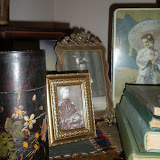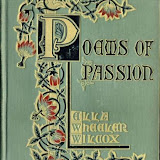 |
| Margaret Armstrong, second left, in 1910 at the family's lake house in North Hatley, Quebec, Canada with friends & sister, Helen, far left, and brother, Hamilton, far right. |
In previous postings (see below), I have referred to Margaret Armstrong. Margaret Nielson Armstrong (1867-1944) was the most productive and accomplished American book designer of the 1890s and early 1900s. Thematically and philosophically, her career places her squarely within the vibrant Arts and Crafts Movement in the United States. Her eclectic style - combining classical and art nouveau with its graceful symmetry and natural motifs, mainly floral in character, rooted in Japonisme and with Colonial, Native American and other motifs - resists easy characterization.

Margaret was the eldest daughter of an old and artistic family, a descendant of Peter Stuyvesant, the Governor of New Amsterdam, on her mother’s side. The family, which eventually included 7 children, spent considerable time on the Hudson River in a 1750's house known as “Danskammer,” inherited by her father; and later spent summer vacations at a lake house in North Hatley, Quebec, Canada. When Margaret was a young girl, the family lived in Florence, where her father, Maitland Armstrong, a diplomat and stained-glass designer and colleague of John LaFarge, practiced his craft. Margaret is said to have enjoyed assisting him in his studio.

In the 1870s the family moved to 58 West 10th Street in Greenwich Village, then the heart of the City’s bohemian artistic community, and where Margaret lived and worked most of her life. Friends and neighbors included artists like Edwin Austin Abbey, Winslow Homer and William Merit Chase, and architect Stanford White, who redecorated the 10th Street house for the Armstrong family. Two of her siblings had significant careers as well: Helen was also an illustrator and artist who often worked on projects with her sister; and her youngest brother, Hamilton Fish Armstrong, served as the managing editor of the journal
Foreign Affairs from 1928-1972 and wrote an autobiography,
Those Days, published in 1963.
Margaret was educated by a governess and studied at the Art Students League. Her career began in 1883 at the age of sixteen when she sent some menus and place cards that she had made to the Women's Exchange in New York City to be sold. She and her sister, Helen, began designing a series of Christmas cards for the family at this time. Her first book cover design was published in 1890. She so feared being exposed as a woman working in what was at that time a man's profession that she submitted her first work,
Sweet William by Marguerite Bouvet, under the name M.N. Armstrong.
Beyond Margaret’s obvious talent, several major exhibitions devoted to book design and bindings at about the same time directed more attention to her work. In 1893 the Chicago World's Columbian Exposition provided an entire building for exhibits relating to women. Her work was displayed here; her cover designs won an award and a mention in Frank Linstow White's 1893 article on "Younger Women in American Art". In 1894, the Grolier Club published a catalog of book artists that described her as a "designer of great versatility and eminent skill" whose "skill in adapting, combining, and creating designs which are almost flawless in excellence has made her book covers famous." In an 1895 article in the
New York Times about the art of book design, she was cited: “Perhaps Charles Scribner’s Sons have as large a collection of signed book covers as any other firm in the city. Margaret Armstrong has designed many of the covers they have brought out, and on several of them appear in an inconspicuous place the initials, 'M.A.' They are delightfully appropriated, these designs of Miss Armstrong, for the books which the covers inclose [sic]; very pretty and artistic, with just enough of the significance of the character of the book – an appropriate suggestion, not a full-fledged illustration to repel the reader instead of luring him on to further pleasing developments within.”

By the turn of the century Margaret was considered to be the most important woman working in book design in this country. She utilized bold and strikingly colored inks and bookcloths, and often designated that gold-stamped areas be both glossy and matte to heighten the effect and create interest. Her use of slightly asymmetrical designs, however, set hers apart from many of her contemporaries. She was extremely prolific, designing more than 300 bindings between 1890-1940, the majority between 1895 and 1911 for Scribner's and Putnam; and designed multiple bindings for several authors, including George Washington Cable, Paul Leicester Ford, Paul Lawrence Dunbar, Paul Bourget, and Frank Stockton. In the years 1900 and 1901 she undertook two major projects with Scribners, a complete series of twelve in uniform blue cloth for the works of Henry Van Dyke and a similar series in lavender for the works of Myrtle Reed. These designs reveal many common elements in her work: a compartmentalized "stained glass" technique which boxed in elements in the designs; the use of botanical designs; symmetry; and the ornamental use of her own distinctive lettering in alphabets and type fonts of her own creation. Two of her most exuberantly lettered covers are Washington Irving’s
The Legend of Sleeping Hollow and
Rip Van Winkle, published by Putnam in 1899.

After 1907 her output of cover designs gradually decreased until about 1913 when she worked almost exclusively on design and writing of her own books and an autobiography by her father,
Day Before Yesterday: Reminiscenses of a Varied Life, published in 1920. In her mid-forties, she spent a few years travelling around the western United States. In 1911, she and some friends were the first women to descend to the floor of the Grand Canyon where she discovered some new flower species. A few years later, in 1915, her first authored book,
Field Book of Western Wildflowers, which included over five hundred of her drawings, was published. In her later years, she also wrote a family history,
Five Generations: Life and Letters of an American Family (1930), for which she also designed the cover, and two very successful biographies,
Fanny Kemble, A Passionate Victorian, in 1938 and
Trelawny, A Man's Life in 1940 as well as three murder mysteries,
Murder in Stained Glass,
The Man with No Face, and
The Blue Santo Murder Mystery.
Influential in her own time, Margaret Armstrong's exceptional book design work has been the focus of several major exhibits during the past 20 years. Books with her designs became scarce and rose sharply in value after a catalog of her titles,
A Checklist of Trade Bindings by Margaret Armstrong, was published by the University of California Library in 1968.





























































%20Virgin%20with%20Child%20at%20Sunset.jpg)













































.jpg)









